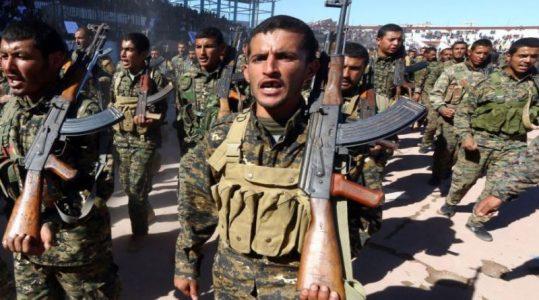
ISIS counterattacks in Syria threaten Iraq and U.S. partners
A reddish sandstorm settled on areas of the Syria-Iraq border over the last week. It turned the air into a reddish soup, where people could not see more than a few meters in front of their face. Through the haze and dust, the Islamic State launched a coordinated counter-attack along a front line near the Euphrates area in an area known as the Hajin pocket. This is the last area ISIS holds in Syria and the US-led Coalition and its Syrian Democratic Forces partners have been seeking to defeat ISIS in Hajin for the last two months.
On October 29, the SDF sent special forces to bolster the front line, according to a spokesman for the Coalition. “The SDF is engaged in a difficult battle and fighting bravely to protect and free their people from ISIS. We salute the martyred SDF heroes as the intense fight against evil continues,” the spokesman wrote. More than a dozen SDF fighters were killed in the clashes and the Syrian Observatory for Human Rights said up to 40 had been killed.
The battle represents a difficult struggle for the SDF which has been dealing with inclement weather this entire month in the area.
On October 10 another sandstorm allowed ISIS to used its unarmored vehicles, trucks that have been welded with extra metal to appear like “mad max tanks” to strike at the SDF. Now the reddish sandstorm, that turned the area into a martian landscape, brought with it death and destruction.
The reinforcements included a series of units, including the SDF special forces, but also members of the Kurdish People’s Protection Units (YPG) and also fighters from a mostly Christian unit known as the Syriac Military Council. They were supposed to support the primarily Arab Deir ez-Zor Military Council of the SDF which has been leading the fight in Hajin.
The plethora of different groups and organizations is part of the unique way the SDF is organized and reflects how the war against ISIS has unfolded in eastern Syria. As the YPG was able to push ISIS back in 2015 it helped form the SDF as an umbrella group that includes a number of fighting units. But these are of varying quality and experience and the battle in Hajin, particularly in the sandstorm against hardened ISIS fighters, has been difficult for the DMC.
Online commentators who follow the battle have disparaged the DMC as badly trained and not able to hold the line. A number of villages that the SDF had cleared over a month of tough house to house fighting were attacked by ISIS during recent days. ISIS swept into Susah and the town of Baghuz near the Iraqi border.
As ISIS headed toward the Iraqi border and the SDF appeared in disarray the Popular Mobilization Units, a group of mostly Shi’ite fighters on the Iraqi side of the border who are a paramilitary unit of the Iraqi government, began receiving orders to hold fast. “Fulfill your patriotic duty and stop any ISIS attempts to enter Iraq,” fliers read that were given to the troops. ISIS reached a high point called Mount Baghuz. (Jabal Baghuz) and the town of Baghuz Faqani was taken.
The difficulty of the battle in what the Coalition calls the “MERV” or Middle Euphrates Valley, illustrates that ISIS is still a formidable force. Army Col. Sean Ryan, spokesman for the Coalition’s Operation Inherent Resolve said that the the SDF had fought bravely to gain ground but that the battle is “give and take sometimes.” ISIS was able to gain some temporary ground back, but overall, they have been on the defensive for months, he said. “ISIS is using experience foreign fighters with nothing to lose, a lot of IEDs [improvised explosive devices] and suicide vests.” The battle has been difficult from the beginning and the Coalition knows both sides “received losses,” but he did not provide the exact numbers. “We are helping expedite their resupply capabilities and continue air support and artillery fires to support the SDF.” The SDF is also facing other issues. In Manbij in northern Syria, which the SDF liberated from ISIS in 2016, the US is seeking to begin joint patrols with Turkey, while Turkey shelled YPG-held areas in Kobani in northeastern Syria. Thus while the SDF were fighting in Hajin, it is also concerned about tensions in the north and expects that its US partners will prevent artillery fire across the border. The US meanwhile faces the complex problem of fighting ISIS with its partners while Washington’s NATO ally Turkey claims the YPG are “terrorists.”
As the battles continue in Hajin the US is shoring up its presence in eastern Syria, increasing its diplomatic footprint, encouraging involvement in infrastructure and continuing to train local forces for what it calls “stabilization.” The back and forth battles in Hajin, which were supposed to go slowly, but smoothly, as ISIS is strangled, are now proving more deadly. This could also reveal ISIS long term strategy to remain on the ground in Syria and Iraq.
Source: JP





